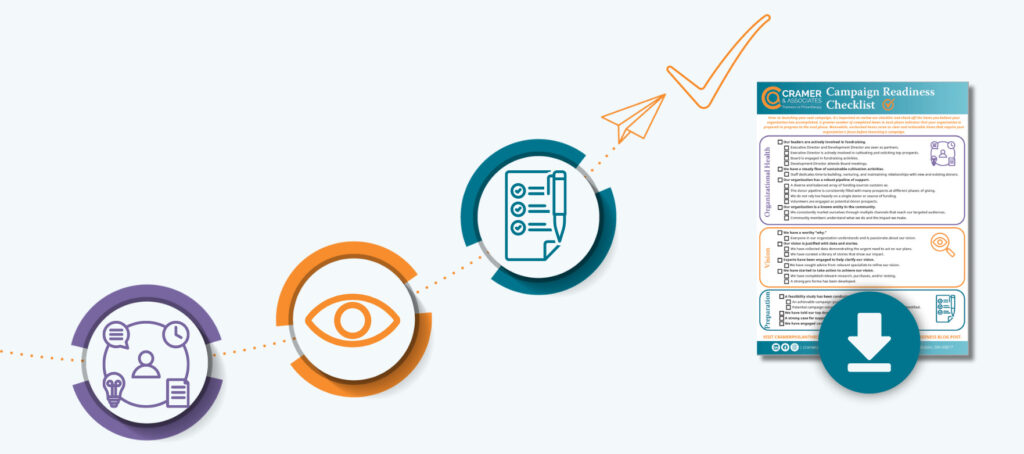Nonprofits today are realizing that long-term planning is imperative to thrive, grow and create the biggest impact. Typically, a master plan conversation is sparked because an organization begins to think ahead and wants to coordinate the use of physical space with its program and service needs, or its infrastructure is aging. With our philanthropic partnerships, Cramer has walked alongside and provided support services to nonprofit organizations as they go through this tedious master planning process.
Here are ten central master planning tactics that you should keep in mind when preparing for and conducting a master plan:
1. Keep your mission central
Your mission must be at the center of your long-range planning process. Board, staff and planners must continually be reminder that the plans need to support the mission of the organization. A key tip is to put your mission statement at the beginning of every presentation and agenda. This will remind everyone why we are doing a master plan.
2. Engage, meet new friends and rekindle relationships
An essential part of the master plan process is involving your key stakeholders and aligning resources to achieve a central goal. During the process, it is important to develop new relationships for your organization. These new relationships may bring ideas to the table that your organization has never imagined. It is also an opportunity for your nonprofit to rekindle relationships and invite individuals back to the table. This engagement will provide capacity-building for your organization’s future.
3. Involve the community & pause and listen
Involving the entire community is a win for your organization while you are master planning. Your organization must stop and listen to their thoughts and ideas. You shouldn’t be in the responsive mode and portray to the community that you already have it all figured out. Having a two-way dialogue is important – listening and sharing. A helpful hint is to turn presentations into roundtable discussions.
4. Develop a master planning timeline and stick with it
Because you are involving a lot of partners throughout the master planning process, developing a timeline and sticking to it is imperative to success. Developing a month by month plan and communicate the actions at the beginning of each month to Board, staff and planners will keep you on track to achieve a final plan. A helpful hint is to have one individual within the organization serve as the ‘chief leader’ to ensure everyone is meeting deadlines.
5. Be open to original ideas
The first part of master planning is getting all the ideas on the table from all your stakeholders. At this stage it’s important to be open to different and original ideas. Don’t eliminate ideas due to the old adage ‘we’ve already tried that’ because someone may add another idea that takes it to a new level.
6. Ensure third party consultants and planners understand your mission
Your nonprofit should require that all third party consultants and planners visit your organization, walk through the facilities, buildings and grounds and experience your mission in action first hand. Their understanding about what you do is critical to your master planning process as the individuals working on your plan need to be able to articulate your mission and give examples of who you serve and how you deliver your programs and services. It’s important that you don’t skip this step.
7. It’s only the first step
A master plan is only the first step of creating a thriving and growing organization. After the vision and plan is affirmed, it’s time to get started. Your next step might be conducting a feasibility study to figure out if there is philanthropic support available for a capital campaign that might be on the horizon. You may also need to conduct a program assessment to evaluate the program growth and services your are planning. Conducting a master plan takes a lot of work, but turning the vision into reality is key for every organization.
8. Develop a team to lead master planning – volunteers, Board members and staff
By developing a team to help with the master plan process, you are engaging key constituents to be involved with the future of your nonprofit. Putting a team together will help you diversify your skill sets, and engage expertise to help lead the process.
9. It’s a living plan
A master plan is a living, breathing document. It should never be put on the shelf and dusted off every so many years to bring to a Board meeting. Your Board and staff should be utilizing this document to help plan next year’s goals and future goals down the road. This plan will also help you plan financially for the future.
10. Communicate, communicate and communicate throughout the master planning process & beyond
It’s imperative you communicate with your stakeholders about the master plan process. Your staff and Board should communicate key touchpoints through print and digital communications. If you are part of the team that is steering the process, you are hearing about master planning every day. Your stakeholders will also need to hear about where you are in the process regularly. Develop the frequency of communications that seems right for your organization and it shouldn’t be just at the beginning or end of the master planning process.
Reach out to see how Cramer can help you through the master planning process today!






